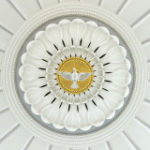It is a joy to be again with Rabbi Jack Bemporad. In 1987, when the controversy over Chancellor Waldheim of Austria threatened the meeting planned between Pope John Paul II and Jewish leaders in the United States, Rabbi Bemporad emerged as one of those who represented the Synagogue Council of America in meetings with representatives of our Ecumenical and Interreligious Affairs Committee.
Eventually, succeeding Rabbi Mordecai Waxman, Rabbi Bemporad became co-chair of the group that met twice annually and dealt with subjects like moral values in public school education, pornography, and – this was a continuing agenda item – Israel, the emerging Palestinian state, and the small but ancient Christian population there.
This occurred against the background of the great changes initiated by the Second Vatican Council in the area of Catholic-Jewish relations. The foundation for our new approach was first presented to that Council’s assembly of the world’s Catholic bishops in 1962-1963 by Cardinal Augustin Bea, a German scriptural scholar who had been a close advisor to Pope Pius XII. Cardinal Bea was named by Pope John XXIII to lead efforts for dialogue with Christian and Jewish leaders on issues of common interest.
On November 19, 1963, Cardinal Bea rose to address the Council on the theme of Catholic-Jewish relations. In an address which struck me at the time as extremely significant and challenging, Cardinal Bea recalled how Pope John XXIII personally directed the Council to take up the issue and explained why it was “so necessary” to treat it. He cited the Holocaust and how Nazi propaganda used arguments “drawn from the New Testament and from the History of the Church.” It was a question, he continued, “of rooting out from the minds of Catholics any ideas which perhaps remain fixed there through the influence of that propaganda.”
Thus began the legislative history of what was to become Nostra Aetate, the Council’s Declaration on the Relationship between the Catholic Church and non-Christian Religions. Solemnly enacted by the Council on October 28, 1965, its third chapter presented the relationship between Church and Synagogue in terms which responded to Pope John XXIII’s original directive.
The Declaration made these principal points:
- There are profound spiritual ties which link the people of the Church to “that people with whom God in His inexpressible mercy established the ancient covenant.”
- As St. Paul points out, Christ, “according to the flesh,” pertains to the Jewish people (cf. Romans 9:4-5). The Virgin Mary, the Apostles and, indeed, very many in the infant Church, were Jewish.
- Although some Jews opposed the spread of the gospel of Jesus, “nevertheless, according to the Apostle, the Jews still remain most dear to God because of their fathers, for He does not repent the gifts He makes nor of the calls He issues (cf. Romans 11:28-29).”
- The Church draws nourishment from the revelation contained in the Hebrew Scriptures. The Law, the Prophets, and Psalms and the wisdom literature – all are part of a heritage given to that people with whom God made a covenant through Abraham. (Addressing this point further, the Holy See’s Commission for Religious Relations with Jews in 1985 underscored the Catholic belief that the covenant between God and the Jewish people continues to exist. Pope John Paul II in Australia referred to “an irrevocable covenant”; in Warsaw, to “that election to which God is faithful.”)
- “Since the spiritual patrimony common to Christians and Jews is thus so great, this sacred Synod [the Second Vatican Council] wishes to foster and recommend that mutual understanding and respect which is the fruit above all of biblical and theological studies and of brotherly dialogues.”
- With specific reference to texts of the Christian scriptures, the Council points out that what happened to Jesus in “his suffering cannot be

